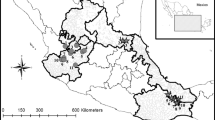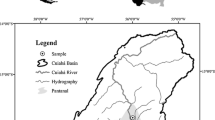Summary
Data on brown trout in Norway and on Arctic char in Norway, Iceland, Greenland or Canada are used to make three points about life-history invariants. First, invariants constructed from adaptive programmes of development that are conditioned on growth and mortality rates are more complicated than those constructed solely on the basis of dimensional analysis, but are more consistent with the data. Second, if one allows the possibility of escaping a size ceiling (e.g. by switching from planktivory to piscivory) ‘ferox trout’ — brown trout that are exceptionally large and long lived — are predicted with the theory only if mortality is size dependent and the growth rate on food sources with different asymptotic sizes differs. Third, a successful empirical approach for finding life-history invariants can be more fully understood as the result of adaptive programmes of development.
Similar content being viewed by others
References
Alm, G. (1959) Connection between maturity, size and age in fishes.Rep. Inst. Freshwater Res., Drottningholm 40 5–145.
Applegate, R.L. and Kruckenberg, W.L. (1978) First-year growth and food of largemouth bass in a South Dakota borrow pit stocked with fathead minnows.Prog. Fish Cult. 40 7–8.
Barry, J.P. and Tegner, M.J. (1990) Inferring demographic processes from size-frequency distributions: simple models indicate specific patterns of growth and mortality.Fish. Bull. US 88 13–19.
Berry, R.J. (1989) British mammals: from trinomials to evolutionary ecology.Biol. J. Linn. Soc. 38 113–18.
Beverton, R.J.H. (1961) Maturation, growth and mortality of clupeid and engraulid stocks in relation to fishing.Rapp. Pro.-Verb. Reun Conseil Perm. Inter. l'Explor. de la Mer 154 44–67.
Beverton, R.J.H. (1987) Longevity in fish: some ecological and evolutionary considerations. InEvolution of longevity in mammals (A. D. Woodhead and K. H. Thompson, eds) pp. 161–85. Plenum Press, New York.
Beverton, R.J.H. (1992) Patterns of reproductive strategy and parameters in some marine teleost fishes.J. Fish Biol. 41 (Suppl. B 136–60.
Beverton, R.J.H. and Holt, S.J. (1959) A review of the life-spans and mortality rates of fish in nature, and their relationship to growth and other physiological characteristics.CIBA Found. Coll. Ageing 54 142–80.
Briand, F. and Cohen, J.E. (1984) Community food webs have scale invariant structure.Nature 307 264–6.
Calder, W.A. (1984)Size, Function and Life History. Harvard University Press, Cambridge, MA.
Campbell, R.N. (1979) Ferox trout,Salmo trutta L., and char,Salvelinus alpinus (L.), in Scottish lochs.J. Fish Biol. 14 1–29.
Charnov, E. (1991) Pure numbers, invariants and symmetry in the evolution of life histories.Evol. Ecol. 5 339–42.
Charnov, E. (1993)Life History Invariants. Oxford University Press, Oxford, UK.
Charnov, E. and Berrigan, D. (1990) Dimensionless numbers and life history evolution: age of maturity versus the adult lifespan.Evol. Ecol. 4 273–5.
Charnov, E.L. and Parker, G.A. (1995) Dimensionless invariants from foraging theory's marginal value theorem.Proc. Natl Acad. Sci. USA 92 1446–50.
Elliott, J.M. (1994)Quantitative Ecology and the Brown Trout. Oxford University Press, Oxford, UK.
Ferguson, A. and Mason, F.M. (1981) Allozyme evidence for reproductively isolated sympatric populations of brown troutSalmo trutta L. in Lough Melvin, Ireland.J. Fish Biol. 18 629–42.
Ferguson, A. and Taggart, J.B. (1991) Genetic differentiation among sympatric brown trout (Salmo trutta) populations of Lough Melvin, Ireland.Biol. J. Linn. Soc. 43 221–37.
Finch, C.E. (1990)Longevity, Senescence and the Genome. University of Chicago Press, Chicago, IL.
Georgiadis, N. (1985) Growth patterns, sexual dimorphism and reproduction in African ruminants.Afr. J. Ecol. 23 75–87.
Gilliam, J.F. and Fraser, D.F. (1987) Habitat selection when foraging under predation hazard: a model and a test with stream-dwelling minnows.Ecology 68 1227–53.
Giske, J., Aksnes, D. and Forland, B. (1993) Variable generation times and Darwinian fitness measures.Evol. Ecol. 7 233–9.
Hamilton, K.E., Ferguson, A., Taggart, J.B., Tomasson, T., Walker, A. and Fahy, E. (1989) Post-glacial colonization of brown trout,Salmo trutta L.:Ldh-5 as a phylogeographic marker locus.J. Fish Biol. 35 651–64.
Hoenig, J.M. (1983) Empirical use of longevity data to estimate mortality rates.Fish. Bull. 82 898–903.
Huxley, J. (1993)Problem of Relative Growth. Johns Hopkins University Press, Baltimore, MD.
Ilina, L.K. (1973) Povedenie segoletkov okunya,Perca fluviatilis L., raznykh ekologicheskikh grupp v. potomstve odnoi pary proizvoditelei.Vopr. Ikthiol. 13 350–61.
Juanes, F. (1994) What determines prey size selectivity in piscivorous fishes? InTheory and application in fish feeding ecology (D. J. Stouder, K. L. Fresh and R. J. Feller eds) pp. 79–100. University of South Carolina Press, Columbia, SC.
Juanes, F., Buckel, J.A. and Conover, D.O. (1994) Accelerating the onset of piscivory: intersection of predator and prey phenologies.J. Fish Biol. 45 (Suppl. A), 41–54.
Kamler, E. (1992)Early Life History of Fish. An Energetics Approach. Chapman and Hall, New York.
Langley, P., Simon, H.A., Bradshaw, G.L. and Zytkow, J.M. (1987)Scientific Discovery. Computational Explorations of the Creative Process. MIT Press, Boston, MA.
Le Cren, E.D. (1992) Exceptionally big individual perch (Perca fluviatilis L.) and their growth.J. Fish Biol. 40 599–625.
Lin, C.C. and Segel, L.A. (1974)Mathematics Applied to Deterministic Problems in the Natural Sciences. Macmillan, New York.
McGurk, M. (1986) Some remarks on ‘Model of monthly marine growth and natural mortality for Babine Lake Sockeye salmong (Oncorhynchus nerka)’ by Furnell and Brett.Can. J. Fish. Aquat. Sci. 43 2535–7.
Mangel, M. (1992) Rate maximizing and state variable theories of diet selection.Bull. Math. Biol. 54 413–22.
Mangel, M. (1994) Climate change and salmonid life history variation.Deep Sea Res. II (Topical Studies Oceanogr.) 41 75–106.
Mangel, M. and Clark, C.W. (1988)Dynamic Modeling in Behavioral Ecology. Princeton University Press, Princeton, NJ.
Mangel, M. and Ludwig, D. (1992) Definition and evaluation of the fitness of behavioral and developmental programs.Ann. Rev. Ecol. Syst. 23 507–36.
Nonacs, P., Smith, P.E., Bouskila, A. and Luttbeg, B. (1994) Modeling the behavior of the northern anchovy,Engraulis mordax, as a schooling predator exploiting patchy prey.Deep Sea Res. II (Topical Studies Oceanogr.) 41 147–69.
Ovsyannikov, L.L. (1992) Evolutionary optimal trajectory of organismal development.Zhur. Obsh. Biol. 53 992–1107 (in Russian).
Ovsyannikov, L.L. (1993) Energetics and evolutionary optimality of characters of an organism.Zhur. Obsh. Biol. 54 341–56 (in Russian).
Pauly, D. (1980) On the interrelationships between natural mortality growth parameters, and mean environmental temperature in 175 fish stocks.J. Cons. Inter. Explor. de la Mer 39 175–92.
Peterson, I. and Wroblewski, J.S. (1984) Mortality rate of fish in the pelagic ecosystem.Can. J. Fish. Aquat. Sci. 41 1117–20.
Preston, F.W. (1960) Time and space and the variation of species.Ecology 41 785–90.
Richards, F.J. (1959) A flexible growth function for empirical use.J. Exp. Bot. 10 290–300.
Roff, D. (1991) The evolution of life-history variation in fishes, with particular reference to flatfishes.Netherlands J. Sea Res. 27 197–207.
Roff, D. (1992)The Evolution of Life Histories. Chapman & Hall, New York.
Stahl, W.R. (1962) Similarity and dimensional methods in biology.Science 137 205–12.
Stearns, S. (1992)The Evolution of Life Histories. Oxford University Press, New York.
Stephens, D.W. and Dunbar, S.R. (1993) Dimensional analysis in behavioral ecology.Behav. Ecol. 4 72–183.
Thompson, D. (1959)On Growth and Form, Vol. I and II. Cambridge University Press, Cambridge, UK.
Vollestad, L.A. and L'Abee-Lund, J.H. (1994) Evolution of the life history of Arctic charSalvelinus alpinus.Evol. Ecol. 8 315–27.
Vollestad, L.A., L'Abee-Lund, J.H. and Saegrov, H. (1993) Dimensionless numbers and life history variation in brown trout.Evol. Ecol. 7 207–18.
von Bertalanffy, L. (1957) Quantitative laws in metabolism and growth.Q. Rev. Biol. 32 217–31.
Wickler, A.M. and Johnson, W.E. (1987) Relationships among fat content, condition factor, and first-year survival of Florida large mouth bass.Trans. Am. Fish. Soc. 116 264–71.
Wootton, R.J. (1990).Ecology of Teleost Fishes. Chapman & Hall, New York.
Author information
Authors and Affiliations
Rights and permissions
About this article
Cite this article
Mangel, M. Life history invariants, age at maturity and the ferox trout. Evol Ecol 10, 249–263 (1996). https://doi.org/10.1007/BF01237683
Issue Date:
DOI: https://doi.org/10.1007/BF01237683




